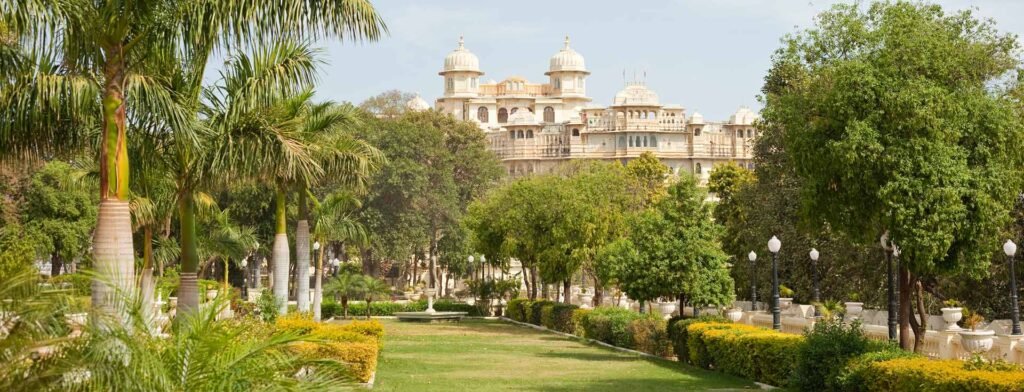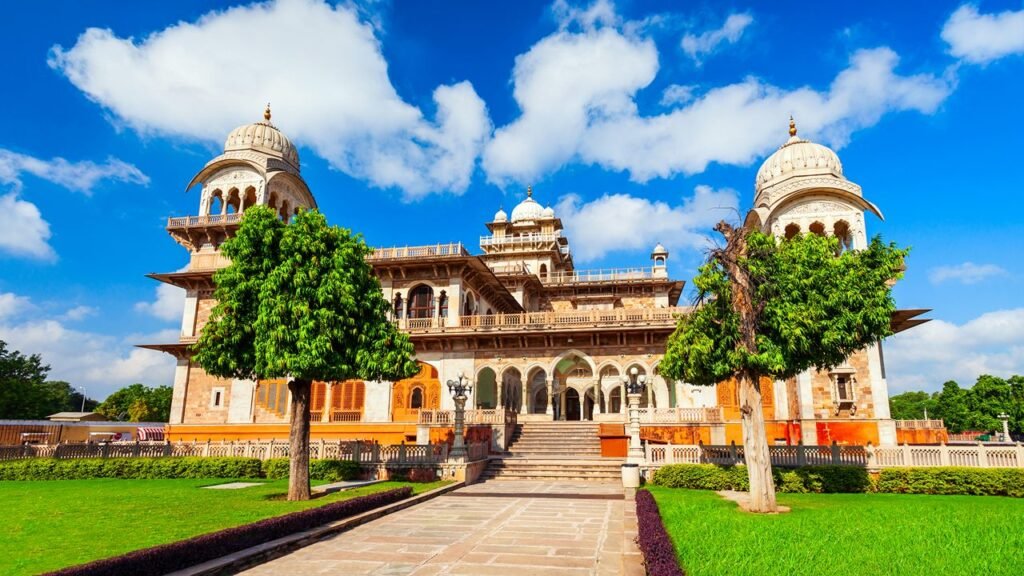Located in the colorful heart of Jaipur, Ram Niwas Garden is a sprawling 33-acre green oasis blending Mughal-inspired design, royal legacy, and vibrant cultural attractions. Built in 1868 by Maharaja Sawai Ram Singh II, this legendary garden remains a testament to Rajasthan’s opulence, blending nature, art, history, and modern leisure experiences.
Location, Route & Accessibility
Ram Niwas Garden is situated at JLN Marg, Ashok Nagar, in central Jaipur, Rajasthan, adjacent to the iconic MI Road and right opposite Albert Hall Museum. Key access points and directions:
- Distance from Jaipur Railway Station: Approx 5 km
- From Jaipur International Airport: Approx 11 km (about 35-40 minutes by taxi or auto-rickshaw)
- The garden is centrally located, within easy reach of all major traffic points in Jaipur.
GPS Coordinates: 26.91528°N, 75.81869°E
Key Details:
Travel Tip: Local transport options include auto-rickshaws, taxis, and app-based cabs. Parking available at the garden entrance.
History of Ram Niwas Garden
Ram Niwas Garden traces its roots to 1868, when Jaipur faced the dire challenges of famine and drought. Maharaja Sawai Ram Singh II, inspired by Victorian public gardens and the Mughal Charbagh layout, commissioned the garden to provide employment as well as a royal retreat for residents. The renowned Colonel Sir Swinton Jacob designed the complex, complete with walkways, grand lawns, planted beds, and stunningly symmetrical landscaping.
Costing over 4 lakh rupees at the time, a monumental sum, it was not only a symbol of power but practical generosity. The garden’s layout and features echo the royal need for order and aesthetics, reflecting both Mughal grandeur and British influence prevalent in 19th century Rajasthan.
Architectural and Cultural Significance
At the heart of the garden sits the imposing Albert Hall Museum, a marvel of Indo-Saracenic architecture. The museum houses an impressive collection of art, artifacts, jewelry, costumes, manuscripts, and even an Egyptian mummy, drawing tourists, students, and art lovers from across the globe.
Ram Niwas Garden is more than a green escape; it’s a living showcase of Jaipur’s cultural and artistic legacy:
- Ravindra Rang Manch: An amphitheater hosting cultural shows, drama, and exhibitions
- Bird Park and Zoo: Home to native and exotic species, offering educational and recreational value
- Floral beds and fountains: Merging natural and manmade beauty, especially stunning at dusk or after the monsoon
- Venues for fairs and festivals: Local Rajasthani arts, crafts, and food festivals draw crowds throughout the year
Tourist Attractions and Experience
Ram Niwas Garden is centrally located in Jaipur, making it easily accessible by road from all parts of the city. Its features attract a diverse crowd, families, students, bird watchers, photographers, and solo travelers. Popular activities and attractions include:
- Albert Hall Museum: History buffs can marvel at coin collections, miniature paintings, and ancient artifacts.
- Zoo and Bird Park: Children and adults alike enjoy spotting parrots, deer, peacocks, and many more species.
- Ravindra Rang Manch: Experience Rajasthani theater, music, and dance.
- Masala Chowk: Enjoy authentic Rajasthani street food in the garden precincts.
- Picnic spots and walkways: Lush lawns and shaded paths perfect for outings.
The garden also hosts seasonal flower shows, craft bazaars, and cultural events, cementing its reputation as Jaipur’s vibrant public hub.

Entry Fees, Revenue & Timings
The garden maintains nominal admission charges and attracts significant footfalls year-round:
| Visitor Type | Entry Fee |
|---|---|
| Indian Nationals | ₹10 |
| Foreign Tourists | ₹100 |
| Indian Students | ₹10 |
| Parking/Guide/Lunch | As per usage |
Timings: Open from 9:00 am to 5:00 pm (Closed on Tuesdays).
Given its centrality and continued popularity, Ram Niwas Garden generates substantial revenue via ticketing, food courts, guided tours, craft fairs, and parking fees, contributing to local tourism economics and job creation.
Recent News and Conservation Efforts
As of September 2025, Ram Niwas Garden made headlines due to a temporary two-day closure aimed at rat control. Thousands of rodents had threatened both the garden’s greenery and the foundation of Albert Hall Museum, prompting authorities to use large-scale pest control and safeguard this heritage site. Such challenges highlight the need for ongoing conservation and maintenance amid heavy footfall and urban pressures.
Cultural Vibrancy and Community Role
Ram Niwas Garden stands as a testament to Jaipur’s enduring spirit of public life and cultural vibrancy:
- It remains a popular destination for both locals and tourists, providing respite and recreation in the city’s most bustling area.
- The garden’s roles, relaxation, education, art, and culture, come alive in every corner, from open-air theaters and museum corridors to sprawling picnics and bustling pathways.
During monsoon, the rain-washed greenery adds an ethereal charm to the site, while on festival days, the campus pulsates with color, music, and local street foods.
FAQs About Ram Niwas Garden, Jaipur
What is the history behind Ram Niwas Garden?
Ram Niwas Garden was built in 1868 by Maharaja Sawai Ram Singh II, inspired by both Mughal gardens and Victorian-era public spaces. It was envisioned as a royal oasis as well as a famine relief work.
What are the main attractions inside the garden?
Key features include the Albert Hall Museum, Jaipur Zoo, Bird Park, Ravindra Rang Manch amphitheater, Masala Chowk food court, landscaped gardens, fountains, and regular fairs and cultural events.
How do tourists reach Ram Niwas Garden?
The garden is located on JLN Marg in central Jaipur, easily accessible by car, taxi, or public transport from the railway station and airport.
What are the timings and entry fees?
Timings: 9:00 am – 5:00 pm (Closed Tuesday); Entry: ₹10 for Indians, ₹100 for foreigners, ₹10 for Indian students.
Are there any current restrictions or news about the garden?
In September 2025, the garden and Albert Hall Museum closed for two days as officials conducted rodent control following an increase in the local rat population that threatened its heritage structures.
Can visitors enjoy food and shopping inside?
Yes, food courts such as Masala Chowk offer classic Rajasthani and Indian cuisine, and various local craft bazaars bring a taste of Rajasthan’s handicrafts and souvenirs.
Is the garden suitable for children and families?
Ram Niwas Garden’s zoo, bird park, lawns, and regular events make it a favorite for children, school groups, and families seeking recreation or educational activities.
Are there guided tours or cultural events?
Guided tours are available for the museum and garden. The Ravindra Rang Manch regularly hosts theater, music, and art festivals, adding to the garden’s cultural allure.
Conclusion
Ram Niwas Garden is not just a city park, but a living legacy, a meeting ground of nature, history, and vibrant Jaipur culture. From architectural glories and historical treasures to children’s play areas, live performances, and spicy street fare, it offers delights for every age and season. Its ongoing evolution and conservation underscore Jaipur’s commitment to preserving its royal past while catering to modern-day recreational needs.
